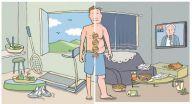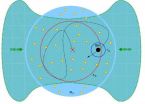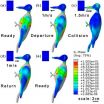(Press-News.org) The protein mTOR is a central controller of growth and metabolism. Deregulation of mTOR signaling increases the risk of developing metabolic diseases such as diabetes, obesity and cancer. In the current issue of the journal Proceedings of the National Academy of Sciences, researchers from the Biozentrum of the University of Basel describe how aberrant mTOR signaling in the liver not only affects hepatic metabolism but also whole body physiology.
The protein mTOR regulates cell growth and metabolism and thus plays a key role in the development of human disorders. In the cell, this regulatory protein is found in two structurally and functionally distinct protein complexes called mTORC1 and mTORC2. In a recent study, the research group of Prof. Michael Hall from the Biozentrum of the University of Basel has shed light on the role of hepatic mTORC1 in whole body physiology and the relevance for human liver cancers.
Hepatic mTORC1 controls whole body physiology
In mammals, the liver is a key organ that controls whole body physiology in response to nutrients. Hall's team investigated the role of the nutrient sensor mTORC1 in this process. The researchers were able to show that activation of mTORC1 in the liver of mice reduces not only hepatic lipid metabolism but also locomotor activity and body temperature. Upon investigating the underlying molecular mechanism, they observed that mTORC1 hyperactivation enhances the level of the stress hormone FGF21 by depletion of the amino acid glutamine. Treatment of animals with glutamine reduced the level of FGF21 and thus prevented the physiological impairments.
Cancer treatment with mTORC1 inhibitors
Human cancers often exhibit aberrant mTORC1 signaling and glutamine addiction. "We were excited to see that in human liver tumors mTORC1 signaling correlates with FGF21 expression", comments cell biologist Dr. Marion Cornu and first author of the study. Moreover, mTORC1 inhibitors such as rapamycin are currently used as immunosuppressive agents and anti-cancer drugs. Thus, the novel findings of Hall's team provide evidence that treatment of glutamine addicted human cancers with rapamycin might have beneficial effects by blocking tumor growth and by preventing deregulation of whole body physiology.
INFORMATION:
Original citation
Marion Cornu, Wolfgang Oppliger, Verena Albert, Aaron M. Robitaille, Francesca Trapani, Luca Quagliata, Tobias Fuhrer, Uwe Sauer, Luigi Terracciano, Michael N. Hall
Hepatic mTORC1 controls locomotor activity, body temperature, and lipid metabolism through FGF21
PNAS; published online 31 July 2014 | doi: 10.1073/pnas.1412047111
Aberrant mTOR signaling impairs whole body physiology
2014-08-11
ELSE PRESS RELEASES FROM THIS DATE:
Not only in DNA's hands
2014-08-11
Blood stem cells have the potential to turn into any type of blood cell, whether it be the oxygen-carrying red blood cells, or the many types of white blood cells of the immune system that help fight infection. How exactly is the fate of these stem cells regulated? Preliminary findings from research conducted by scientists from the Weizmann Institute and the Hebrew University are starting to reshape the conventional understanding of the way blood stem cell fate decisions are controlled thanks to a new technique for epigenetic analysis they have developed. Understanding ...
All-you-can-eat at the end of the universe
2014-08-11
At the ends of the Universe there are black holes with masses equaling billions of our sun. These giant bodies – quasars – feed on interstellar gas, swallowing large quantities of it non-stop. Thus they reveal their existence: The light that is emitted by the gas as it is sucked in and crushed by the black hole's gravity travels for eons across the Universe until it reaches our telescopes. Looking at the edges of the Universe is therefore looking into the past. These far-off, ancient quasars appear to us in their "baby photos" taken less than a billion years after the Big ...
Nanocubes get in a twist
2014-08-11
Nanocubes are anything but child's play. Weizmann Institute scientists have used them to create surprisingly yarn-like strands: They showed that given the right conditions, cube-shaped nanoparticles are able to align into winding helical structures. Their results, which reveal how nanomaterials can self-assemble into unexpectedly beautiful and complex structures, were recently published in Science.
Dr. Rafal Klajn and postdoctoral fellow Dr. Gurvinder Singh of the Institute's Organic Chemistry Department used nanocubes of an iron oxide material called magnetite. As ...
How the woodpecker avoids brain injury despite high-speed impacts via optimal anti-shock body structure
2014-08-11
Designing structures and devices that protect the body from shock and vibrations during high-velocity impacts is a universal challenge.
Scientists and engineers focusing on this challenge might make advances by studying the unique morphology of the woodpecker, whose body functions as an excellent anti-shock structure.
The woodpecker's brain can withstand repeated collisions and deceleration of 1200 g during rapid pecking. This anti-shock feature relates to the woodpecker's unique morphology and ability to absorb impact energy. Using computed tomography and the construction ...
Megascale icebergs run aground
2014-08-11
Scientists from the Alfred Wegener Institute, Helmholtz Centre for Polar and Marine Research (AWI) have found between Greenland and Spitsbergen the scours left behind on the sea bed by gigantic icebergs. The five lineaments, at a depth of 1,200 metres, are the lowest-lying iceberg scours yet to be found on the Arctic sea floor. This finding provides new understanding of the dynamics of the Ice Age and the extent of the Arctic ice sheet thousands of years ago. In addition, the researchers could draw conclusions about the export of fresh water from the Arctic into the ...
Western Wall weathering: Extreme erosion explained
2014-08-11
Visitors to the Western Wall in Jerusalem can see that some of its stones are extremely eroded. This is good news for people placing prayer notes in the wall's cracks and crevices, but presents a problem for engineers concerned about the structure's stability.
The Western Wall is a remnant of the ancient wall that surrounded the courtyard of the Jewish Temple in Jerusalem. It is located in Jerusalem's Old City at the foot of the Temple Mount.
To calculate the erosion in the different kinds of limestone that make up the Western Wall, researchers from the Hebrew University ...
Celebrity promotion of charities 'is largely ineffective,' says research
2014-08-11
Celebrity promotion of charities is ineffective at raising awareness, but can make the stars more popular with the public, new research says.
According to journal articles by three UK academics, "the ability of celebrity and advocacy to reach people is limited" and celebrities are "generally ineffective" at encouraging people to care about "distant suffering".
The research, by Professor Dan Brockington, of The University of Manchester, Professor Spensor Henson, University of Sussex, and Dr Martin Scott, University of East Anglia, is published at time when many celebrities ...
A new cause of osteoarthritis identified by research on a rare disease
2014-08-11
A new mechanism of joint destruction caused by a natural material that grinds away healthy cartilage and worsens osteoarthritis has been identified in human hip joints for the first time by University of Liverpool scientists.
The scientists, with Professor Alan Boyde and colleagues from Queen Mary University of London, were studying the hip of a man with the genetic condition, alkaptonuria (AKU), This is a metabolic disease in which a substance called homogentisic acid accumulates in joint cartilage, causing changes to its physical properties.
The study revealed ...
Challenges and strategies for women pursuing STEM careers
2014-08-11
As a national push continues to recruit talented girls and young women into math and science-related careers, a new study underlines the importance of mentoring and other social support systems for women pursuing those research professions. Mary Jean Amon, a doctoral student in the University of Cincinnati's psychology program, will present her findings at the annual convention of the American Psychological Association in Washington, D.C.
Amon's study uncovered three themes that emerged as women examined the effects of gender stereotypes in STEM fields: career strategies, ...
Sensitive acid sensor controls insulin production
2014-08-11
This news release is available in German. Many human metabolic functions only run smoothly if the acid level in the body remains neutral and stable. For humans, normal blood pH values lie between 7.35 and 7.45. By way of comparison, an empty stomach is extremely acidic, with a pH value of 1.5.
The body constantly monitors this narrow pH band and quickly restores the ideal pH values in the event of any deviations. This is because many proteins cease to function properly if fluids in the body become even slightly more acidic. These proteins become unstable and alter ...





